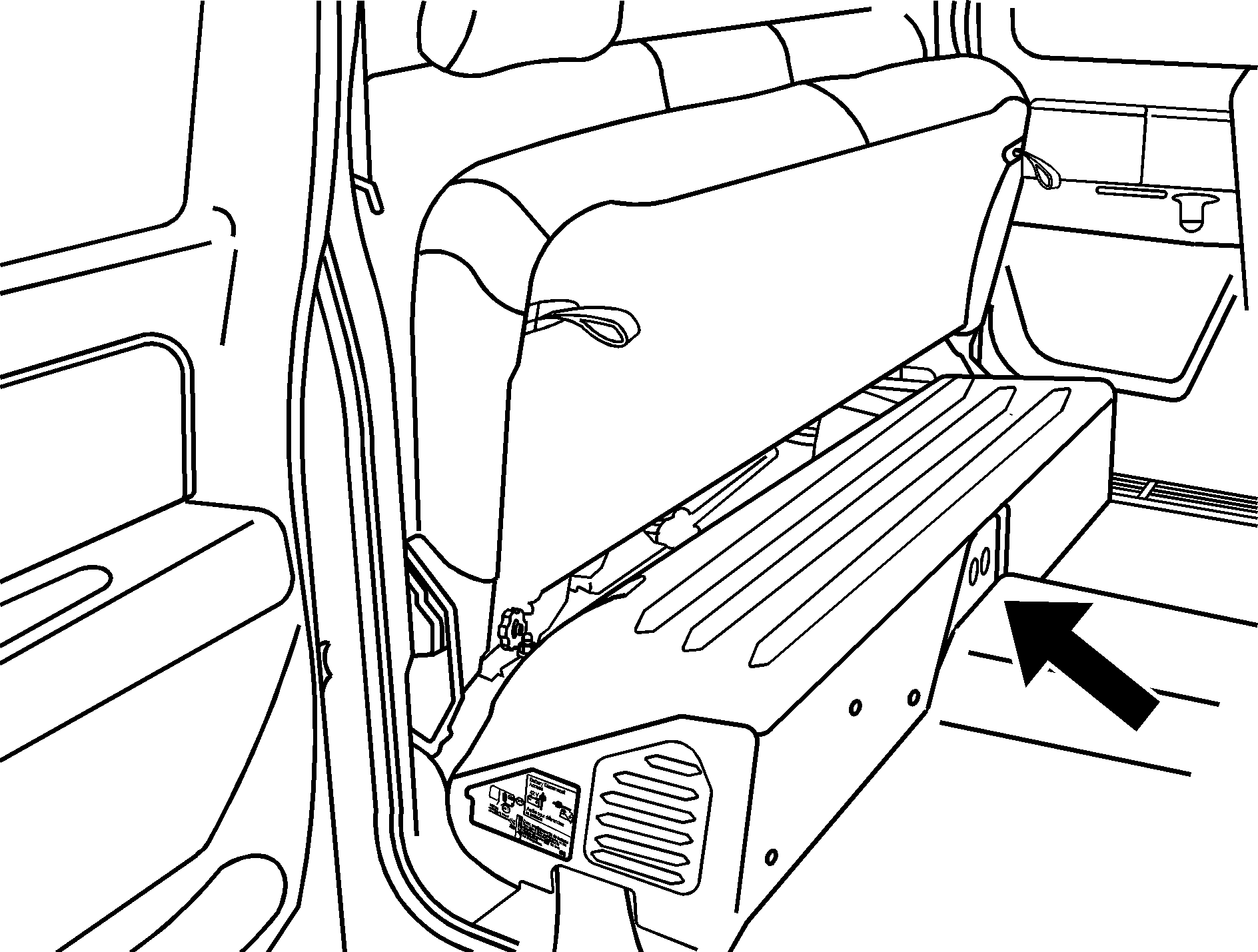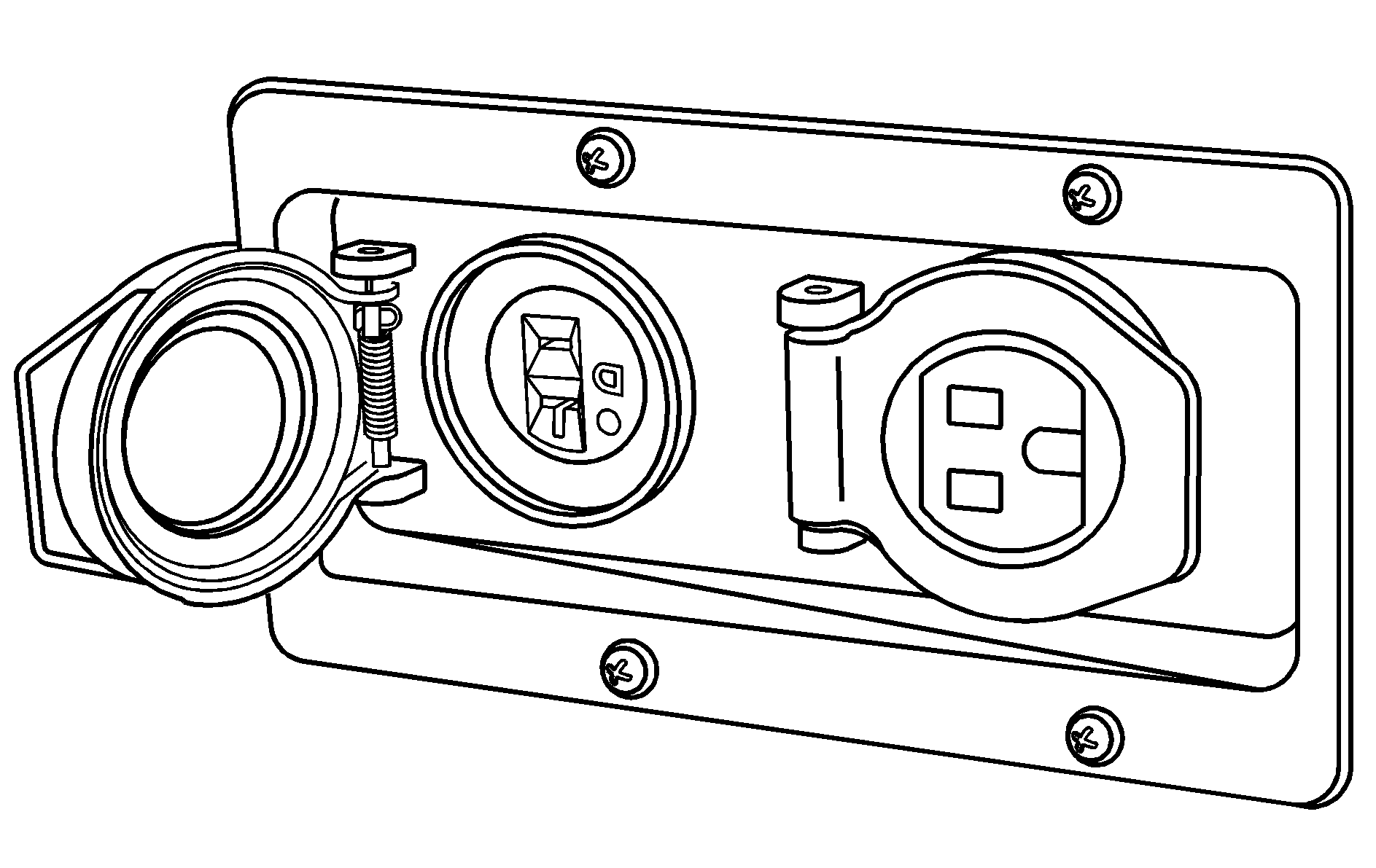The Auxiliary Power Outlet (APO) system provides up to 2,400 watts of 120-volt AC power. With these power outlets, you can plug in most auxiliary electrical equipment and devices with a maximum limit of 2,400 watts. If you try to use equipment that requires more than the limit, a 20-amp protection circuit will cut the power supply and a light in the APO switch will flash along with a Driver Information Center (DIC) message that will flash 120V OVERLOAD. Once this occurs, the system must be reset. See "Resetting the Short Circuit, Overload or Ground Fault Detection (GFD) Circuit" later in this section and DIC Warnings and Messages for more information.
When running APO, do not have the front of the vehicle obstructed. Leave at least five feet (1.5 m) of space between the front of the vehicle and any other object. This will allow airflow through the radiator and help to keep the SGCM cooler.
There are outlets located inside the cabin and in the truck bed.

Inside the vehicle, they are in the middle of the rear seat near the bottom.

In the truck bed, they are located on the passenger side near the tailgate.
The power outlets are not designed for equipment with high initial peak starting power of greater than 2,400 watts, such as some air compressors, table saws, etc.
Short Circuits, Overloads and Ground Fault Detection (GFD)
The 120-volt AC power outlets are protected against short circuits, overloads and ground faults. If the system detects a short or overloaded circuit, it will immediately shut down the outlets and the light next to the APO button will flash, while at the same time a 120V OVERLOAD message will appear in the Driver Information Center (DIC). After the fault condition is corrected, the system can be reset by pressing and releasing the APO button. See "APO Operating Mode" for more information on the APO button. Short circuits may occur because a defective extension cord or defective electrical device is plugged into an outlet.
Some electrical devices, such as motor-driven appliances and tools, have high start-up currents. During this start-up period, the 120-volt AC supply will attempt to start the electrical device for up to 5 seconds. If the current does not fall below the maximum 20 amp rating of the APO within this 5-second timeframe, the system will shut down the outlets and the light next to the APO button will flash, while at the same time a 120V OVERLOAD message in the DIC will appear. This type of situation is unlikely, but if it does happen, press the APO button and try to start the electrical device again. If the electrical device fails to start a second time, it is probably because the device needs more start-up power than is available.
The Ground Fault Detection (GFD) system checks for leakage current to ground, or the truck frame, that could potentially be a shock hazard, in much the same way as the Ground Fault Circuit Interrupt (GFCI) outlets protect you in your home. The GFD self-test is automatically performed during the activation of the APO system. Thereafter, if the GFD system detects a significant leakage current, it will immediately shut down the outlets and the light next to the APO button will flash, while at the same time a 120V GROUND FAULT message will appear in the DIC. If this happens, unplug all electrical devices and reset the system by pressing the APO button. Then plug in each electrical device individually until the malfunctioning extension cord or electrical device is identified.
If, after unplugging all electrical devices and cords and resetting the system, either the 120V OVERLOAD message or the 120V GROUND FAULT message continues to be displayed, have the vehicle serviced.
APO Operating Modes
The APO system is capable of being operated in two different modes:
| • | Normal mode: This is used while the vehicle is running and in PARK (P), the vehicle is in Auto-Stop mode, or the vehicle is moving. |
| • | Continuous mode: This is used while the vehicle is parked. |
Normal Mode
This mode can be activated while in any transmission gear position to supply the outlets with 2,400 watts of 120-volt AC power.
To activate the normal mode do the following:
- Start the engine. See "Starting Your Engine" in the owner manual Index.
- The light next to the APO button will come on, indicating that the system is supplying 120-volt AC power to the outlets.
- Connect your electrical/electronic device(s) to the outlets. Be sure the device(s) is secure so you can drive the vehicle safely. If you must use extension cords, be sure to use only UL® approved extension cords.

Press and release the APO button, located on the instrument panel, once. Do not hold the APO button for more than two seconds.
If the system stops supplying 120-volt AC power unexpectedly and the APO button starts flashing, the system has detected an overload or ground fault condition. To reset the system see "Resetting the Short Circuit, Overload or Ground Fault Detection (GFD) Circuit" later in this section.
The APO system will operate in the normal mode until you turn it off by doing one of the following:
| • | Pressing the APO button. The light in the APO button will turn off. |
| • | Turning the ignition switch to ACCESSORY or LOCK. See "Ignition Positions" in your owner manual Index. |
Continuous Mode
This mode can be operated only when the vehicle is not moving and the transmission is in PARK (P) and will provide up to 2,400 watts of 120-volt AC power to the outlets.
Continuous mode can be operated with the key removed from the ignition. The engine will run continuously in this mode to supply electrical power to the APO system.
You can use the vehicle as a generator in this mode when no electrical power outlets are available or during instances such as power outages. Use this mode to power critical appliances rather than an entire circuit in a home/building. Never connect the APO system outlets directly to a building's circuitry or another power supply.
For more information on running your vehicle while it is parked, see "Parking Over Things that Burn," "Engine Exhaust," and "Running Your Engine While You Are Parked" in your owner manual Index.
To activate the continuous mode, do the following:
- Place the transmission in PARK (P) with the ignition in RUN and the engine running. See "Ignition Positions" in your owner manual Index.
- Press and hold the APO button, located on the instrument panel, for longer than two seconds. The light next to the APO button should begin to flash and the DIC message, 120V READY will appear.
- Turn the ignition key to LOCK while the light is flashing. The light will flash for up to 30 seconds. When the ignition key has been turned to LOCK, the light next to the APO switch will stop flashing and remain on. The engine will continue to run.
- Connect any 120-volt AC electrical/electronic device(s) to the outlets. If you must use extension cords, be sure to use only UL® approved extension cords.

You can remove the key from the ignition at this point.
Caution: Leaving children in a vehicle with the ignition key is dangerous for many reasons, children or others could be badly injured or even killed. They could operate the power windows or other controls or even make the vehicle move. The windows will function with the keys in the ignition and children could be seriously injured or killed if caught in the path of a closing window. Do not leave the keys in a vehicle with children.

If the system stops supplying 120-volt AC power unexpectedly and the light next to the APO button starts flashing, the system has detected an overload or ground fault condition. To reset the system see "Resetting the Short Circuit, Overload or Ground Fault Detection (GDF) Circuit" later in this section.
The APO system will operate in the continuous mode with the engine running until one of the following occurs:
| • | You press the APO button. The light in the APO button will turn off and the engine will turn off. |
| • | If the fuel level gets low. |
| A FUEL LEVEL LOW message will appear in the DIC and the horn will sound intermittently for five seconds every minute for five minutes. |
| If the vehicle is left unattended for the full five minute warning, the engine and APO system will shut down, unless the APO button is pressed during the five minute warning period. See DIC Warnings and Messages for more information on the FUEL LEVEL LOW message. |
| • | An overload or ground fault condition is detected and not reset in five minutes. |
| • | Vehicle security is violated. |
| • | Engine oil pressure becomes too low. |
| • | Engine coolant temperature becomes too hot. |
| • | The ignition key is moved out of LOCK. |
| This may display a low oil warning message and chimes which is a normal condition when the APO button was not used to shut off the continuous mode. |
| • | The hybrid power system becomes too hot. |
Resetting the Short Circuit, Overload or Ground Fault Detection (GFD) Circuit
To reset the Short Circuit, Overload or Ground Fault Detection (GFD) Circuit while operating in both the normal and continuous modes, ensure any observed fault is removed, and press the APO button. The light next to the button will illuminate indicating that the system is supplying 120-volt AC power to the outlets. In the case of an engine shutdown due to a ground fault while in the continuous mode, restart the engine by turning the key from LOCK to START, then follow the instructions for entering APO Continuous Mode earlier in this section.
